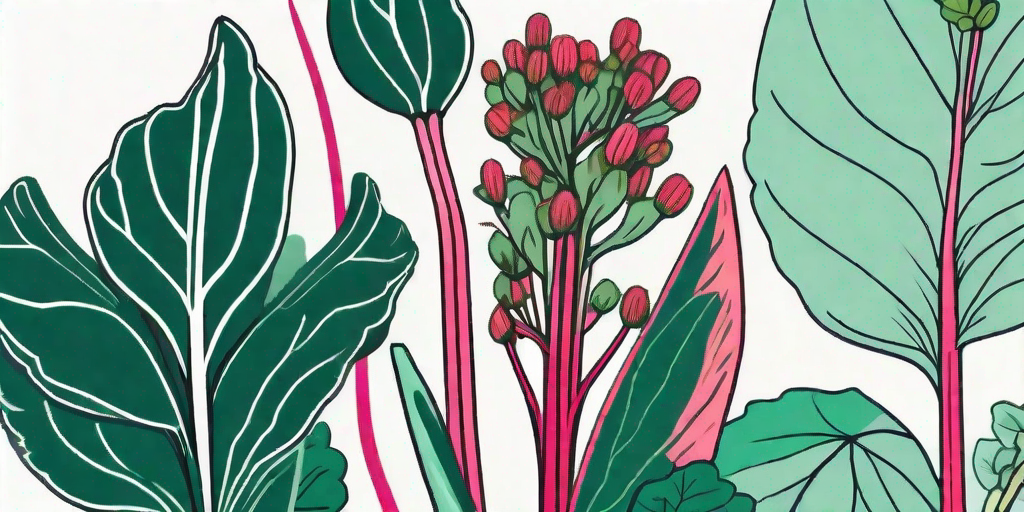
Welcome to the world of rhubarb, where tart meets sweet, and gardening takes on a whole new shade of red. If you're a fan of this unique vegetable (yes, it's technically a vegetable, not a fruit), then you're in for a treat. This guide will take you on a journey from seed to harvest, and everything in between. So, put on your gardening gloves, grab your trowel, and let's get started!
Understanding Rhubarb: A Brief Overview
Before we delve into the nitty-gritty of rhubarb cultivation, let's take a moment to appreciate this versatile veggie. Rhubarb, with its vibrant red stalks and large green leaves, is a sight to behold in any garden. But it's not just a pretty face; rhubarb is packed with vitamins, minerals, and antioxidants, making it a healthy addition to your diet.
Native to Siberia, rhubarb thrives in cooler climates and is a perennial, meaning it can live for many years if properly cared for. It's known for its tart flavor, which is often balanced with sugar in desserts like pies and crumbles. But don't be fooled; rhubarb can also hold its own in savory dishes.
The Rhubarb Plant: Anatomy 101
The rhubarb plant is made up of two main parts: the stalk and the leaf. The stalk, or petiole, is the part we eat. It's firm and crisp, much like celery, but with a tart flavor. The leaf, on the other hand, is not edible. In fact, it's toxic due to high levels of oxalic acid. So, when it comes to rhubarb, remember this simple rule: red is for eating, green is for gazing.
Now that we've covered the basics, let's move on to the fun part: growing your own rhubarb from seeds.
From Seed to Harvest: Your Rhubarb Journey
Step 1: Choosing Your Seeds
When it comes to growing rhubarb from seeds, you have a few options. There are several varieties available, each with its own unique characteristics. Some popular choices include 'Victoria', known for its sweet flavor and high yield, and 'Canada Red', prized for its deep red color and tart taste.
Once you've chosen your variety, it's time to purchase your seeds. You can find rhubarb seeds at most garden centers or online. Just make sure to buy from a reputable source to ensure the quality of your seeds.
Step 2: Planting Your Seeds
Now that you have your seeds, it's time to get planting. Rhubarb seeds should be sown indoors about six weeks before the last expected frost. Use a seed tray or small pots filled with seed compost, and plant your seeds about 1/2 inch deep. Keep the soil moist, but not waterlogged, and place the tray in a warm, sunny spot.
After a few weeks, you should start to see your rhubarb seedlings sprouting. Once they have a few true leaves, they're ready to be transplanted into larger pots or directly into your garden, if the weather permits.
Step 3: Caring for Your Rhubarb
Rhubarb is a relatively low-maintenance plant, but it does require some care to thrive. It prefers well-drained soil and full sun, but can tolerate partial shade. Water your rhubarb regularly, especially during dry periods, but avoid overwatering as this can lead to root rot.
As for feeding, rhubarb benefits from a high-potassium fertilizer in the spring and a general-purpose fertilizer in the fall. And don't forget to mulch around your plants to conserve moisture and suppress weeds.
Step 4: Harvesting Your Rhubarb
After all your hard work, it's finally time to reap the rewards. Rhubarb is typically ready to harvest in the spring, when the stalks are about 12 to 18 inches long. To harvest, simply grab the stalk at the base and pull gently. Remember, only the stalks are edible, so be sure to remove and discard the leaves.
One important note: if you're growing rhubarb from seeds, you'll need to wait until the second year to harvest. This allows the plant to establish a strong root system. But don't worry, your patience will be rewarded with a bountiful harvest for years to come.
Common Questions About Growing Rhubarb
Why isn't my rhubarb red?
Not all rhubarb varieties are red; some are green or speckled. Also, the color can be influenced by growing conditions. Cooler temperatures tend to produce redder stalks, while warmer temperatures can result in greener stalks. But rest assured, the color of the stalk doesn't affect the taste or edibility of the rhubarb.
Can I grow rhubarb in a pot?
Absolutely! Rhubarb can be grown in large pots or containers, making it a great option for those with limited garden space. Just make sure the pot is deep enough to accommodate the rhubarb's extensive root system, and don't forget to water and feed regularly.
Why are my rhubarb leaves turning yellow?
Yellow leaves can be a sign of several issues, including overwatering, poor drainage, or a nutrient deficiency. If your rhubarb leaves are turning yellow, check your watering practices and soil conditions, and consider a soil test to determine if any nutrients are lacking.
Conclusion
And there you have it, a comprehensive guide to growing your own tart and tangy delight: rhubarb. With a little patience and care, you can enjoy a bountiful harvest of this versatile veggie for years to come. So, why not give it a try? Your taste buds (and your garden) will thank you.











